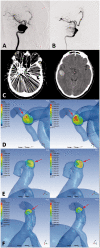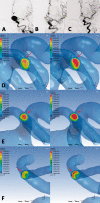Imbalanced flow changes of distal arteries: An important factor in process of delayed ipsilateral parenchymal hemorrhage after flow diversion in patients with cerebral aneurysms
- PMID: 33823618
- PMCID: PMC8673899
- DOI: 10.1177/15910199211009120
Imbalanced flow changes of distal arteries: An important factor in process of delayed ipsilateral parenchymal hemorrhage after flow diversion in patients with cerebral aneurysms
Abstract
Background and objective: Hemodynamic forces may play a role in symptomatic delayed ipsilateral parenchymal hemorrhage (DIPH) of intracranial aneurysm (IA) after flow diverter placement. We aimed to investigate the hemodynamic risk factors in the postsurgical DIPH process.
Methods: Six patients with internal carotid artery (ICA) aneurysm developed to DIPH and 12 patients without DIPH (1:2 matched controls) after flow diverter were included between January 2015 to January 2019. Postsurgical hemodynamics of distal arteries (terminal ICA, middle cerebral artery (MCA), anterior cerebral artery (ACA)) were investigated using computational fluid dynamics, as well as the hemodynamic alteration between pre- and post-treatment. The DIPH related and unrelated distal arteries (either MCA or ACA) were discriminated and compared. Definition of imbalance index is the difference in increased velocity post-flow diverter between MCA and ACA and was used to evaluate the blood flow distribution of distal arteries.
Results: The mean and maximum flow velocities in the terminal ICA increased significantly after treatment in both groups. In DIPH group, the increase rate of mean velocity in the DIPH-related artery was significantly higher than that in DIPH-unrelated artery after the treatment (20.98 ± 15.38% vs -6.40 ± 7.74%; p = 0.028). Between the DIPH and control group, the baseline characteristics were well matched. However, a higher imbalance index of mean velocity was found in DIPH group (27.38 ± 13.03% vs 10.85 ± 14.12%; p = 0.031).
Conclusion: The mean velocity of DIPH related artery increased more, and the imbalance in increased blood flow distribution of distal arteries might play an important role in DIPH after flow diverter of IAs.
Keywords: Intracranial aneurysms; delayed ipsilateral parenchymal hemorrhage; endovascular treatment; flow diverter; hemodynamics.
Conflict of interest statement
Figures





References
-
- Murthy SB, Shah J, Mangat HS, et al. Treatment of intracranial aneurysms with pipeline embolization device: newer applications and technical advances. Curr Treat Options Neurol 2016; 18: 16. - PubMed
-
- Kallmes DF, Brinjikji W, Cekirge S, et al. Safety and efficacy of the pipeline embolization device for treatment of intracranial aneurysms: a pooled analysis of 3 large studies. J Neurosurg 2017; 127: 775–780. - PubMed
-
- Yu SC, Kwok CK, Cheng PW, et al. Intracranial aneurysms: midterm outcome of pipeline embolization device – a prospective study in 143 patients with 178 aneurysms. Radiology 2012; 265: 893–901. - PubMed
-
- Chalouhi N, Starke RM, Yang S, et al. Extending the indications of flow diversion to small, unruptured, saccular aneurysms of the anterior circulation. Stroke 2014; 45: 54–58. - PubMed
MeSH terms
LinkOut - more resources
Full Text Sources
Other Literature Sources
Medical
Miscellaneous

